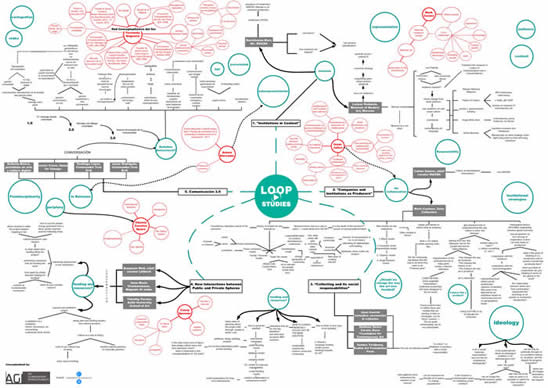LOOP STUDIES PANNEL 4
AGI | Art Globalization Interculturality | Global Visual Cultures
UB | Universidad de Barcelona

LOOP STUDIES PANNEL 4
AGI | Art Globalization Interculturality | Global Visual Cultures
UB | Universidad de Barcelona

PANEL 4. NUEVAS INTERACCIONES ENTRE LO PUBLICO Y LO PRIVADO.
RAPIDAS CONCLUSIONES.
Federica Matelli
2013
(English Version Below)
Durante la charla emergieron cuatro problematicas fundamentales y posibles consecuencias de la intercambiabilidad entre publico y privado en el contexto del patrocinio de la cultura. En primer lugar, se remarcó que uno de los riesgos de un sistema de financiación mixto, si desequilibrado hacia lo privado, podría ser la sobreinfluencia por parte del “sponsor” en el nivel de producción, dàndole preponderancia al marketing por encima de la investigación de los contenidos. Se trata en otras palabras del problema de la sostenibilidad de un sistema mixto, que deja vislumbrar el peligro que la búsqueda de dinero se vuelva la exigencia principal, más que los valores culturales e ideológicos que deberían motivar la investigación artística. La segunda problematica que se resaltó, fue relativa a la inestabilidad de un sistema de financiación preeminentemente privado, que hace que los proyectos sean a merced de las fluctuaciones y de los caprichos del mercado. En tercer lugar se mencionó el tema de la espectacularización del arte contemporáneo, acompañado por la cuarta problemática: el riesgo de monopolios del sector cultural, osea que los fondos privados resulten garantizados sobretodo para los artistas o las galerías de éxito, excluyendo de la escena cultural instituciones emergentes o proyectos alternativos que no se acomodan a los intereses de los màs fuertes.
El debate entorno a la intercambiabilidad entre lo publico y lo privado no puede omitir de tomar en consideración el inevitable factor ideológico que supone el arte y su contexto como entramado complejo. Desde los tiempos de la Agorá griega, lo público es el lugar social, el espacio de debate donde todos pueden desarrollar y ejercer su voluntad política y creatividad. El grado de compromiso con este aspecto de la cuestión es muy importante cuando hablamos de arte o de cultura, en cualquiera de sus facetas, inclusive la económica, sobretodo si recordamos que, como nos enseño Marchel Duchamp, el arte no puede obviar su contexto porque éste completa su significado. Es necesario que exista por parte de las instituciones y de los agentes culturales, como los curadores, una comprensión de la cultura como servicio publico, al mismo tiempo que como patrimonio comunitario, en el cual tiene que confluir la energia social, antes que el poder econòmico y financiero que, siguiendo el lenguaje neo liberal de un planeta en crisis, traduce el arte en profesión, industria u objeto de colección museificable sumiso a las leyes del mercado, mientras debería ser el mayor espacio de salvaguardia para la crítica libre y la responsabilidad social.
//////////////////////////////////////////////////////////////////////////////////////////////////////////////////////////////////////////
PANEL 4. NEW INTERACTIONS BETWEEN PUBLIC AND PRIVATE. FAST CONCLUSIONS.
Federica Matelli
2013
During the talk emerged four fundamental problematics and possible consequences of the interchangeability between the public and the private in the context of cultural sponsorship. First, it was noted that one of the risks of a mixed financing system, if unbalanced towards the private, could be the over influence by the sponsor on the production level, giving preponderance to marketing actions more than to the contents research. It is, in other words, the problem of the sustainability of a mixed system, which leaves a glimpse of the danger that the pursuit of money becomes the primary need rather than cultural and ideological values that should motivate artistic research. The second problematic that was highlighted was the instability of a prominently private financing system, which makes that cultural projects are at the mercy of the fluctuations and vagaries of the market. Thirdly, it was mentioned the issue of contemporary art “spectacolarization”, accompanied by the fourth problem: the risk of cultural sector’s monopolies, is to say that private funding ends up guaranteed especially for successful artists or galleries, excluding from the cultural scene emerging institutions or alternative projects that do not fit the interests of the more powerful.
The debate on the substitutability between public and private can’t leave out to take into account the inevitable ideological factor that art and its context, as a complex framework, involve. From the time of the Greek Agora, the public is the social space for debate where everyone can develop and exercise his political will and creativity. The degree of commitment to this aspect of the issue is very important when we are dealing with art or culture in all its aspects, including the economic one, especially if we remember that, as Marchel Duchamp taught us, art can not ignore its context because this completes its meaning. There needs to be by the institutions and cultural actors, as the curators, an understanding of culture as a public service, and at the same time as community heritage, in which must converges social energy rather than economic and financial power which, following the neoliberal language of a planet in crisis, translates art into a profession, industry or “museificable” collection’s object, subjected to the laws of the market, whereas should be the greatest safeguard space for free criticism and social responsibility.
![]()